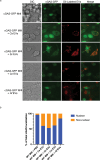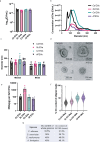Extracellular vesicles from diverse fungal pathogens induce species-specific and endocytosis-dependent immunomodulation
- PMID: 40445992
- PMCID: PMC12157816
- DOI: 10.1371/journal.ppat.1012879
Extracellular vesicles from diverse fungal pathogens induce species-specific and endocytosis-dependent immunomodulation
Abstract
Microbial pathogens generate extracellular vesicles (EVs) for intercellular communication and quorum sensing. Microbial EVs also induce inflammatory pathways within host innate immune cells. We previously demonstrated that EVs secreted by Candida albicans trigger type I interferon signaling in host cells specifically via the cGAS-STING innate immune signaling pathway. Here, we show that despite sharing similar properties of morphology and internal DNA content, the interactions between EVs and the innate immune system differ according to the parental fungal species. EVs secreted by C. albicans, Saccharomyces cerevisiae, Cryptococcus neoformans, and Aspergillus fumigatus are differentially endocytosed by murine macrophages triggering varied cytokine responses, innate immune signaling, and subsequent immune cell recruitment. Notably, polysaccharide and hydrophobic protein structures on the outer layers of C. neoformans and A. fumigatus EVs inhibit efficient internalization by macrophages and dampen innate immune activation. Our data uncover the functional consequences of the internalization of diverse fungal EVs by immune cells and reveal novel insights into the early innate immune response to distinct clinically significant fungal pathogens.
Copyright: © 2025 Kwaku et al. This is an open access article distributed under the terms of the Creative Commons Attribution License, which permits unrestricted use, distribution, and reproduction in any medium, provided the original author and source are credited.
Conflict of interest statement
The authors have declared that no competing interests exist.
Figures





Update of
-
Extracellular vesicles from diverse fungal pathogens induce species-specific and endocytosis-dependent immunomodulation.bioRxiv [Preprint]. 2025 Jan 3:2025.01.03.631181. doi: 10.1101/2025.01.03.631181. bioRxiv. 2025. Update in: PLoS Pathog. 2025 May 30;21(5):e1012879. doi: 10.1371/journal.ppat.1012879. PMID: 39803513 Free PMC article. Updated. Preprint.
References
-
- Pekmezovic M, Hovhannisyan H, Gresnigt MS, Iracane E, Oliveira-Pacheco J, Siscar-Lewin S. Candida pathogens induce protective mitochondria-associated type I interferon signalling and a damage-driven response in vaginal epithelial cells. Nat Microbiol. 2021;6(5):643–57. - PubMed
MeSH terms
Grants and funding
LinkOut - more resources
Full Text Sources
Medical
Research Materials

